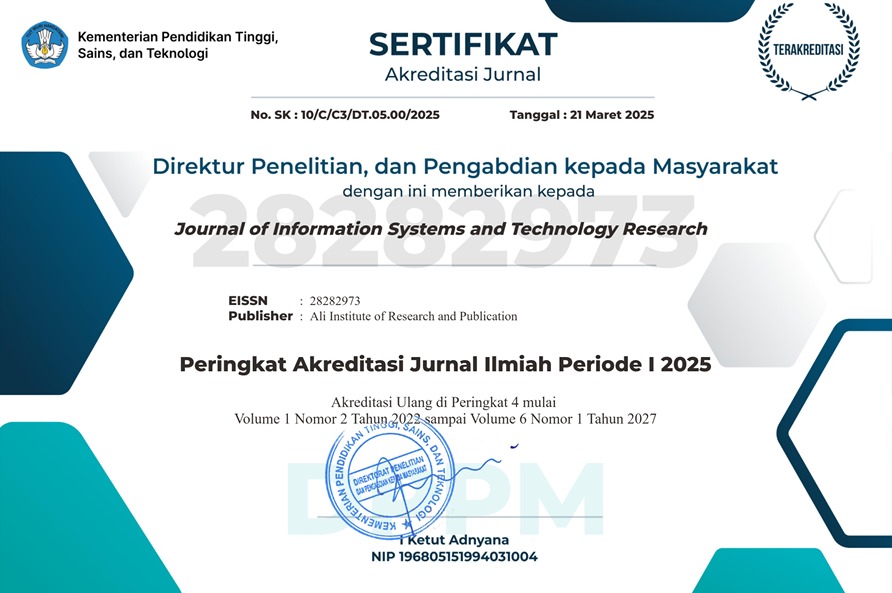Application Of The Triple Exponential Smoothing Method In Predicting Electronic Equipment Inventory Based On Customer Demand
DOI:
https://doi.org/10.55537/jistr.v2i2.616Keywords:
Forecasting, Product Inventory, Triple Exponential SmoothingAbstract
PT. Wira Dwika is a company engaged in the production of electronic equipment and product distribution is carried out after the production process takes place. The obstacle that is often faced by companies is the difficulty in determining the number of products that will be provided by the company so that errors often occur in fulfilling customer requests and in predicting supplies for the next period. The system that runs at the company still uses a manual system so that errors often occur in determining the number of products to be distributed, and the Inventory section also often has difficulty determining the stock to be provided in future periods and the demand is more than the number of products already available in production. So it greatly affects profit and loss as well as inventory data processing. So the researchers used the Triple Exponential Smoothing Method to overcome the obstacles faced by the company because the Triple Exponential Smoothing method is an effective method in terms of forecasting. Electronic equipment still uses workbook paper and is less efficient in making product inventory reports. The electronic equipment inventory report input system still uses Microsoft Excel 2007 so that the data obtained is inaccurate and does not yet use electronic equipment inventory storage with a database system, by implementing PHP applications and MySQL databases it can help companies calculate predictions of electronic equipment distribution in the next period. So that it greatly affects profit and loss as well as processing inventory data for electronic equipment still using paper workbooks and is less efficient in making product inventory reports.
Downloads
References
D. T. Kusuma, M. F. Rifai, and M. Y. Sudirman, “Penerapan Metode Triple Exponential Smoothing Pada Sistem Prediksi Keuntungan Bisnis Ayam Broiler Guna Meningkatkan Pengelolaan Keuangan Peternak,” Kilat, vol. 8, no. 2, pp. 103–111, 2019, doi: 10.33322/kilat.v8i2.551.
A. P. Kusuma, I. H. Santi, and D. Setiawan, “Sistem Peramalan Penjualan Produk Usaha Kecil Menengah Berdasarkan Pola Data Riwayat Penjualan,” Antivirus J. Ilm. Tek. Inform., vol. 11, no. 2, pp. 113–133, 2018, doi: 10.35457/antivirus.v11i2.270.
A. I. Jaya and Teti Desyani, “Perancangan Aplikasi Forecasting Penjualan Dengan Metode Moving Average Dan Exponential Smoothing Berbasis Web Designing Sales Forecasting Applications With Web-Based Moving Average and Exponential,” vol. 4, pp. 134–145, 2020.
N. Jumadil, I. Siti Hartina, and P. Bambang, “Peramalan Persediaan Obat Menggunakan Metode Triple Exponential Smoothing (Tes) (Studi Kasus : Instalasi Farmasi Rsud Kab. Muna),” vol. 4, no. 1, pp. 135–142, 2018.
R. Hermiati, A. Asnawati, and I. Kanedi, “Pembuatan E-Commerce Pada Raja Komputer Menggunakan Bahasa Pemrograman Php Dan Database Mysql,” J. Media Infotama, vol. 17, no. 1, pp. 54–66, 2021, doi: 10.37676/jmi.v17i1.1317.
H. Riyadli, A. Arliyana, and F. E. Saputra, “Rancang Bangun Sistem Informasi Keuangan Berbasis WEB,” J. Sains Komput. dan Teknol. Inf., vol. 3, no. 1, pp. 98–103, 2020, doi: 10.33084/jsakti.v3i1.1770.
R. Y. Hayuningtyas, “Implementasi Metode Triple Exponential Smoothing Untuk Prediksi Penjualan Alat Kesehatan,” EVOLUSI J. Sains dan Manaj., vol. 8, no. 1, pp. 29–35, 2020, doi: 10.31294/evolusi.v8i1.7404.
N. W. Saputra, R. K. Niswatin, and ..., “Penerapan Metode Triple Exponential Smoothing pada Aplikasi Peramalan Penjualan Jenis Meubel di UD. Karya Jati,” Pros. SEMNAS INOTEK (Seminar Nas. Inov. Teknol., vol. 3, no. 1, pp. 217–222, 2019, [Online]. Available: https://proceeding.unpkediri.ac.id/index.php/inotek/article/view/540.
Y. E. Achyani and S. Saumi, “Penerapan Metode Waterfall Pada Sistem Informasi Manajemen Buku Perpustakaan Berbasis Web,” J. SAINTEKOM, vol. 9, no. 1, p. 83, 2019, doi: 10.33020/saintekom.v9i1.84.
O. Alfina and F. Harahap, “Pemodelan Uml Sistem Pendukung Keputusan Dalam Menetukan Siswa Siswa Tunagrahita,” Methomika J. Manaj. Inform. Komputerisasi Akunt., vol. 3, no. 2, pp. 143–150, 2019.
F. N. Hidayat and I. H. Al Amin, “Implementasi Metode First in First Out (Fifo) Untuk Analisa Sistem Antrian Pengaduan Pelanggan Internet Service Provider (Isp),” Dinamik, vol. 23, no. 2, pp. 73–79, 2019, doi: 10.35315/dinamik.v23i2.7180.
S. Julianto and S. Setiawan, “Perancangan Sistem Informasi Pemesanan Tiket Bus Pada Po. Handoyo Berbasis Online,” Simatupang, Julianto Sianturi, Setiawan, vol. 3, no. 2, pp. 11–25, 2019, [Online]. Available: https://journal.amikmahaputra.ac.id/index.php/JIT/article/view/56/48.
S. Kurniawan, T. Bayu, “Perancangan Sistem Aplikasi Pemesanan Makanan dan Minuman Pada Cafetaria NO Caffe di TAnjung Balai Karimun Menggunakan Bahasa Pemrograman PHP dan My.SQL,” J. Chem. Inf. Model., vol. 53, no. 9, pp. 1689–1699, 2020.
W. S. Hasibuan, M. D. Irawan, and R. I. Pulungan, “Sistem Informasi Pengaduan Jaringan Internet pada Dinas Komunikasi dan Informatika Padang Lawas Berbasis Web,” 2022.
F. C. Ningrum, D. Suherman, S. Aryanti, H. A. Prasetya, and A. Saifudin, “Pengujian Black Box pada Aplikasi Sistem Seleksi Sales Terbaik Menggunakan Teknik Equivalence Partitions,” J. Inform. Univ. Pamulang, vol. 4, no. 4, p. 125, 2019, doi: 10.32493/informatika.v4i4.3782.
Downloads
Published
How to Cite
Issue
Section
License
Copyright (c) 2023 Muhammad Lutfil Amin Siregar Lutfil, Samsudin, Triase

This work is licensed under a Creative Commons Attribution-ShareAlike 4.0 International License.







